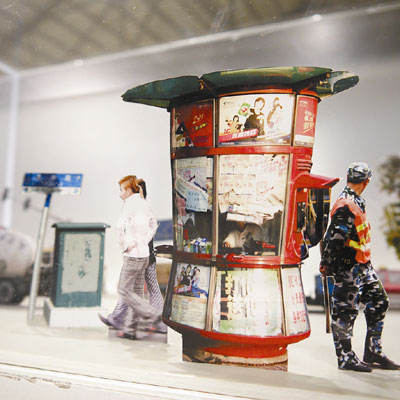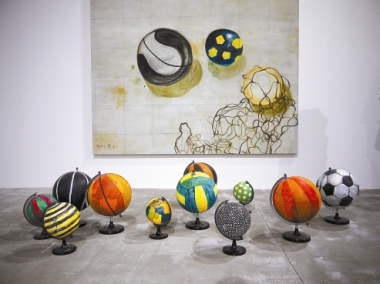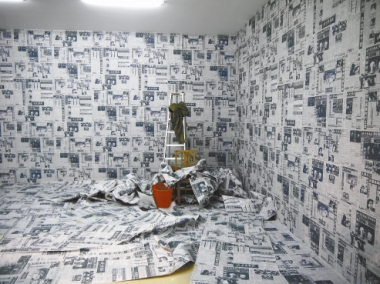


Cao Zhen
AS much of contemporary art marches toward standardized production, artists Liu Ding, Lu Yinghua and Su Wei are favoring a return to individual styles, independent spirits and personal responses to art’s industrialization.
The Seventh Shenzhen Sculpture Biennale has just begun and focuses on the topic of individualism. Curated by Liu, Lu and Su, all from Beijing, the three-month festival gives 49 artists from 10 countries a platform to display their message, at OCT Contemporary Art Terminal’s Hall A and B, and at OCT-LOFT North Zone’s B10.
Titled “Accidental Message: Art Is Not a System, Not a World,” the exhibition includes two subthemes: “Unexpected Encounters” and “What You See Is What I See.”
“Unexpected Encounters” focuses on experimental art creations of the 1990s in China. It strives to present a concrete view of the experience, ideas, dilemmas and anxieties portrayed in art from that period. “What You See Is What I See” displays works from all over the world in recent years.
Although the exhibition has two parts, paintings, installations, videos and photographs weave together at the OCT-LOFT locations. “This is a de-centralized exhibition, no central topic, no classification,” said curator Liu.
Different views
In “Unexpected Encounters,” curators selected creative works with a global vision, focusing on artists that use distinctive mediums and methods to comment on social and economic issues.
“Newspaper — Interior Decoration” is an installation work created by Wang Youshen in 1993. Wang, a former art editor at Beijing Youth Daily, pasted newspapers on walls to turn the hot medium of high clarity and dense information into a cold medium of low clarity and murky information.
The installation reflects China’s first real estate boom in the early 1990s. Wang believed that waves of economic transformation and swells of information were flooding into people’s daily lives. Newspapers were merely a tool for the interests of politicians and businessmen, affecting ordinary people’s judgment and choices.
Another striking work is a black-and-white photo series, “Did They Have Sex?” by pioneering Chinese photographer Zhu Jia. In 1995, Zhu instructed his assistant to hold a sign reading “Did They Have Sex?” between randomly selected male and female passers-by who would unwittingly become part of the photographs.
In the early days of China’s reform and opening up, Zhu used the alluring topic of sex to invoke taboo topics and produce comic effects. World artist and curator Hou Hanru once pointed out that this work can be viewed as a satirical take on the authorities’ methods of forcing their “official voice” into everyday life and political or cultural discussions.
Cultural blends
“What You See Is What I See” features artists from China, Japan, Britain, Belgium and Germany, among other locales. The diversity of backgrounds reflects the exhibit’s diverse, individual spirits.
Lee Mingwei, who immigrated to the United States from Taiwan in his youth, uses his art to explore life experiences brought by multiple cultures and clashes.
In his installation work “Quartet Project,” four monitors are installed on the four walls of a dark room. Each monitor, with its back to visitors, is playing one of the four parts in Antonin Dvorak’s 1893 composition “American String Quartet.”
In the dark room, the dim light and pleasing music entice visitors to crane their necks, trying to catch a glimpse of the screens. However, this curiosity cannot be satisfied because whenever someone approaches a monitor, a sensor shuts off the music and the visitor only hears the other three parts. Visitors can only enjoy the whole quartet from a distance. This forced a sense of distance and mystery is intended to preserve visitors’ purity of experience when appreciating “American String Quartet.”
Lee said his abstract work strives to show that although cultural diversity is being disseminated at unprecedented speeds these days, a culture’s interpretation is often distorted or simplified by the media, under the influence of globalization. The quartet scenario, in which it is impossible to simultaneously enjoy the four parts of the performance if you are too close to a monitor, is a subtle reference to the contradictory state of shuffling between multiple cultures.
Other options
Also during the biennale, Vienna-based artist Joseph Dabernig’s movies will be shown on the afternoons of May 19 and 20 at OCT Art and Design Gallery, and on the afternoons of May 26 and 27 at OCT-LOFT.
The versatile artist’s creations include photography, installations, architecture and writing. His installation for the biennale, “A Study of Relationships Between Overhead Crossings and Pedestrian Passage,” is placed in OCT-LOFT’s North Zone outdoor space.
The biennale ends Aug. 31.
|

